





If you have a moist site and want to extend the blooming season, then look no further than the turtleheads. This North American wildflower is an up and coming star in the plant world!
(Editor's Note: This article was originally published on February 14, 2009. Your comments are welcome, but please be aware that authors of previously published articles may not be able to promptly respond to new questions or comments.)
It seems that most of the genera of plants grown in our North American gardens hail from Europe or Asia. Only a handful of ornamentals are purely North American natives. Phlox, Rudbeckia and Echinacea are a few examples. Another genus, perhaps not as popular as those previously mentioned, is Chelone, commonly called turtlehead. In Greek mythology, Chelone was a nymph who made derogatory remarks about the marriage of Zeus and Hera. In retribution, she was turned into a tortoise, condemning her to eternal silence. Within the Greek language, chelone then became the word for tortoise (and hence the derivation of the common name for this plant).
There are only four species within the genus Chelone. In the wild, they grow on the edges of streams, lakes, bogs and wet thickets throughout eastern North America. Based on their growing preferences in the wild, they prefer a moist site. To accommodate them in the garden, position them in full sun and incorporate plenty of organic material in the growing area as a means to help increase the soil moisture. They do not require wet soil, but will suffer if the soil does not remain at least evenly moist. As Chelone grow 60 to 120 cm, they are ideal for the mid to back portion of a moist border or for utilizing near water features. Plants are stiffly upright and form reasonably large clumps over time. Their paired leaves are lance-shaped with serrated margins. The flowers are terminal in a dense head, blooming in mid-late summer and often well into the fall. Blooms, which are indeed shaped like a turtlehead, come in white or pink shades and make admirable cut-flowers. The resulting seed heads are attractive enough to use in dried-flower arrangements.
The most widespread and hardiest species is the white turtlehead or balmony, C. glabra. This plant extends west to Manitoba and Minnesota, east to Newfoundland and south to Georgia and Mississippi. Rated to zone 3, it is the hardiest species. Although not as showy as the other species, this one does have fragrant flowers. There are at least nine botanical varieties that exhibit slightly varying botanical differences. The species C. chlorantha and C. montana, sometimes found in older literature, are now classified as varieties of the white turtlehead. Flowers are typically white but may have a green or pink flush. ‘Montana' is distinctively purple-pink. Native Americans used this species as a medicinal plant to treat sores, fevers and as a gentle laxative.
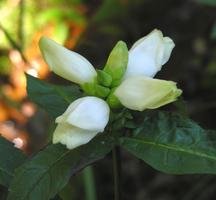
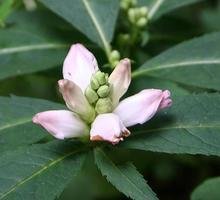
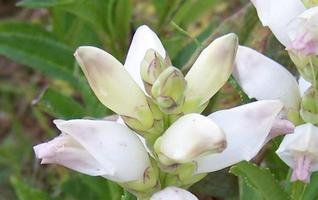
Various colour forms of C. glabra
Pink and red turtlehead actually encompasses two very similar species, C. lyonii and C. obliqua. The former species is found in highland regions along the eastern seaboard from Maine south to Mississippi while the latter is a lowland species extending from the western Great Lakes south to Arkansas, Mississippi and the Southeastern states. The difference is mainly in the foliage which is narrow and elongate on C. obliqua while wider and more ovate on C. lyonii. Both are rated hardy to zone 4. 'Hot Lips' is a popular cultivar of C. lyonii with shiny dark-green leaves and rose-pink flowers.
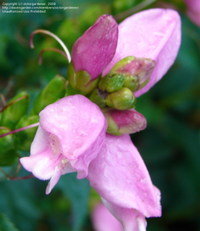
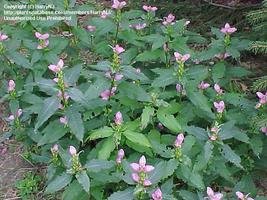
Details of C. obliqua
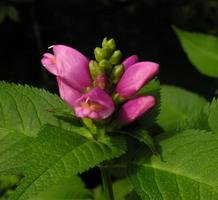
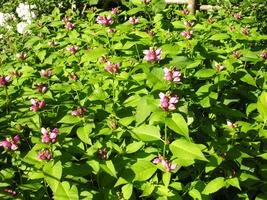
Details of C. lyonii
Chelone cuthbertii has the most restricted natural range, found in mountainous areas of Southeastern U.S. from Virginia to Georgia. The flowers are very much like the pink or red turtlehead but the leaves are sessile (attached directly to the stem rather than having a leaf stalk). This species does not appear to be commonly cultivated. Most literature rate it hardy to at least zone 5.
Once classified as C. nemorosa is the now re-classified Notochelone nemorosa, a western species extending from British Columbia south to California. The flowers of this species are more like those of Penstemon or Physostegia, being distinctly two-lipped with flared openings. This species is rarely grown as a garden ornamental.
With their love of moist soils, turtleheads are ideal companions for rayflowers (Ligularia), rose mallow, astilbe, blue lobelia, cardinal flower, flag iris and various sedges. They are particularly valued for their late flowers, produced in the season when many other perennials have gone to seed. Relatively new as a garden ornamental, plant breeders are only now starting to look at possible new improved forms such as 'Hot Lips'. I expect more named varieties will arise in the near future, so keep your eyes open!
I would like to thank the following people for the use of their pictures: HarryNJ (C. obliqua full plant) and victorgardener (C. obliqua close-up)
Copyright © www.100flowers.win Botanic Garden All Rights Reserved